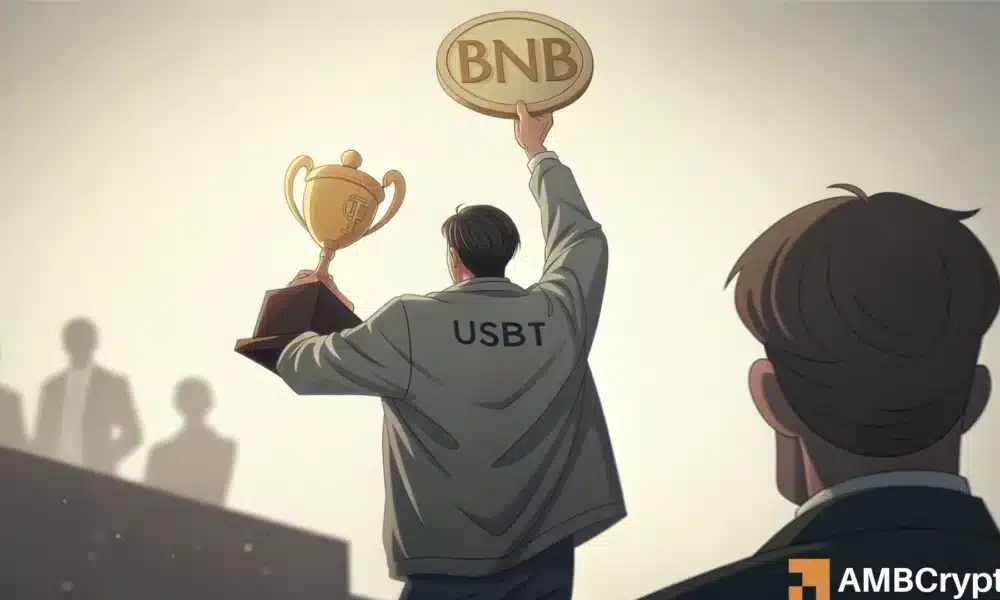BNB Chain on the Rise: A Closer Look at USDT Transfer Volume and On-Chain Adoption
In recent months, the Binance Coin (BNB) chain has witnessed a noteworthy increase in USDT transfer volume, surpassing 20%. This surge marks a significant shift in the on-chain dynamics, suggesting a potential rebranding of BNB as a key player in the Layer 1 (L1) landscape. As the cryptocurrency ecosystem continues to evolve, these developments underscore a vital question: What do these changes mean for BNB’s adoption and network relevance?
Historically, Tron (TRX) has been the leader in Tether (USDT) flows, currently commanding 48.69% of the total market, while Ethereum (ETH) trails closely with 42.23%. The Binance Smart Chain (BSC) contributes a relatively modest 4.06%. This dominance indicates that Tron is attracting the majority of liquidity on chain. However, the disparity between transfer volume and actual usage raises intriguing questions. Could this gap be paving the way for BNB to emerge as a serious contender in the L1 domain?
The importance of USDT in the crypto space cannot be overstated, as it drives more than 60% of all stablecoin activity and functions as a primary liquidity rail for various protocols. According to analytics from Glassnode, from Q4 2022 onwards, Tron consistently maintained over 50% of the USDT transfer volume, while Ethereum hovered around the 20% mark, and other chains collectively secured less than 30%. However, the latest figures reveal a decline in Tron’s share to 45%, while BNB’s numbers have seen a substantial increase to beyond 20%, with Ethereum reclaiming more than 30%.
These statistics reflect a sustained trend rather than a fleeting moment. BNB’s uptick in USDT transfer volume signifies that the BSC is capturing a larger slice of the stablecoin liquidity pie, despite retaining a mere 4% market share. This shift is particularly significant, as it indicates growing confidence in BNB as a viable settlement layer—needed for not just “safe haven” trades but also for powering decentralized finance (DeFi) activities and the overall on-chain transaction volume. In this context, the rise in USDT transfer on BSC signals a repositioning of the network, further enhancing its relevance in the ever-competitive crypto environment.
As the liquidity landscape adapts, it’s crucial to monitor where these funds ultimately settle. Since the beginning of the third quarter, Tron’s Total Value Locked (TVL) has increased from $5 billion to $6.2 billion—an impressive 24% growth. In comparison, BSC’s TVL jumped from $6 billion to $7.8 billion, reflecting a robust 30% increase. These figures indicate that BNB is genuinely enhancing on-chain capital deployment, functioning as a source of liquidity when market conditions shift favorably.
Supporting this trend, TRX has yielded a return on investment (ROI) of 23.3% during the same quarter, while BNB has outperformed with an impressive 28.41% ROI. This performance underscores a growing appetite for BNB within the investor community. In fact, the TRX/BNB trading pair recently recorded its first negative quarterly candle since Q1 of 2024. Such market dynamics, coupled with the increasing daily active addresses on BSC—rising 17% over three months to 226,000—illustrate tangible adoption and user engagement.
In summary, the surge in USDT transfer volume on the Binance Smart Chain is a critical indicator of its growing traction as a Layer 1 contender. The evolving on-chain metrics showcase BNB’s rising significance as both a liquidity engine and settlement layer within the cryptocurrency ecosystem. With these shifts arriving amid Tron’s declining dominance, it appears that Binance Chain is strategically positioning itself for a more substantial role in the overall market, offering a promising future for BNB and its users. As we move forward, ongoing developments in market behavior and adoption will undoubtedly be pivotal in determining BNB’s trajectory.


